In India : the Land of Snakes and Serpents Part I , I left you with a question.
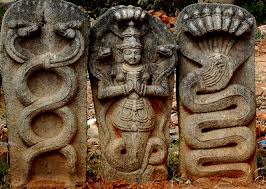
What do the Stones with snake motifs like this one in the picture above signify?
I also promised to answer the question in Part II of the Series. So here goes…
If you have traveled around interior India, particularly in the South, it is likely that you have come across these kind of stones under trees.

Known as snake stones, or Nagakalu, they are found in particular, under Neem, Peepal and Banyan trees, outside temples and ponds or at entrances of villages and towns.
What do they signify? Why are they there?
Several scholars have asked this question and here’s what seems to be the likely answer. But first, as I am trying to help you explain this to children – some background on symbols.
Need for Symbols
Over millennia, humans have created various symbols for the purpose of communication. The words we use are also symbols that carry meaning.
While some words and ideas are plainly simple to communicate such as, Sun, Moon, Star or Man, Woman, Child with words or symbols, certain other ideas are more evolved, complex and hence more difficult to communicate.

It is in this context, that human beings evolved a set of symbols to denote more complex ideas and emotions.
So for instance, a heart is used to convey love. A diamond ring to convey a proposal. A cake with candles signifies a birthday. And so on.

In some cases, there may be no correlation between the symbol used and the idea being conveyed (clearly, diamonds have nothing do with marriage!) except that humans have formed a connection between the two based on some association followed by repeated usage.
It is in light of this background that Snake Stones need to be understood.
Snakes as Symbols
The snake has been used as a symbol across cultures.
Like a river that winds its way through land, the snake creeps along the ground and although it dwells inside the earth, it emerges like a fountain from below.
It is thus seen as a symbol of the deep body of mother Earth. And it’s Fertility to support and create life.
The serpent also coils itself in circles…often making it difficult to tell one end of its body from the other.
This renders itself appropriately to symbollize Eternity – as one can’t tell the beginning nor the end.
This helps in depicting beautifully the view of the Universe as per Indian Cosmology – Anadi and Ananth. Having no beginning. And no End.
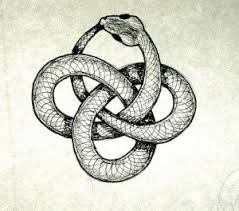
Snake Stones
Returning then to the question of the Snake Stones.
The entwined serpent pair is a motif that has been found in early Mesopotamian art. It has been suggested that this is a symbol that has come down from ancient times on stone slabs, some exhibiting a snake queen of the mermaid type or some with the serpent tail and human body and a halo of several cobra hoods.
Others also exhibit a snake with the number of heads or a serpent pair facing each other entwined in an embrace.
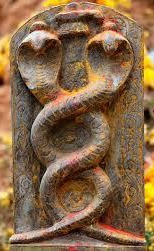
These stones with the snake motifs were worshipped for progeny. Women desiring children propitiated these stones as they were regarded as a symbol of Fertility. They symbollized the Fertility of Mother Earth, from whose womb they emerged.
It is said that when a sculptor prepared such a stone, it was placed in a pond for about 6 months to become imbued with the life force of the water. It was further treated with ritual and then the stone was set up under a neem or peepal tree. These 2 trees are often found together in the countryside as they are regarded as married couples.
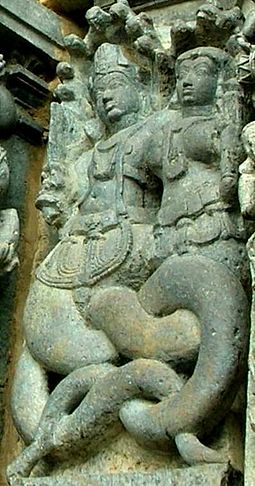
It is no surprise then, that snakes play a key role in Indian myths and folk tales. We have all heard of the famous episode of Krishna conquering the serpent Kalia – it makes for one of the most popular motifs in Indian art and iconography.
Krishna and Kalia
It is said that Krishna was a young 7-year-old when he came to a dangerous place by the river Yamuna, where the water was boiling and whitish with foam. It was said that this was the region of the underwater den of the great serpent king Kalia who scorched and burnt all creatures with his fiery venom.

While the story is more than familiar, what I find most interesting is what follows.
After being subdued, an exhausted Kalia says to Krishna…
“I have only acted according to my nature. As you created me with strength and endowed me with my venom, so have I behaved. Had I comported myself otherwise, I should have violated the laws laid down by you for every creature according to its kind; I should have challenged the order of the universe and be liable therefore the punishment. But now, even in striking me, you have blessed me with the highest boon, the touch of your hand. My force is broken, my venom spent; I implore you to spend my life to me and declare what I must do.”

“You shall not henceforth reside in the waters of the Yamuna,” replies Krishna, “but in the vastness of the ocean. I declare to you that Garuda the sun-bird of gold, arch enemy of all serpents and my vehicle through the reaches of space forever shall spare you, whom I have touched.”
What I find interesting about the end of this episode is that the serpent is not killed.
Further, the serpent pleads that it has acted only according to its nature and not done anything evil.
Good and bad, virtue and vice, glory and evil – are human values that are often superimposed on the natural world. Judging the predator as evil and prey as innocent is not the way Nature sees things. They are human points of view.
This story (and certain other lovely Indian folk stories that I have had occasion to read), contrary to those found in fables like the Panchatantra and Aesop’s Fables, make for a more reasonable understanding of the wild. I hope to recount some of these lovely folk tales at some point in my blog. (You can sign up for the newsletter to stay updated)
Serpents in World Mythology
Serpents are not a popular motif in Indian mythology alone. The world over, snakes have been a symbol of something deeper.
In the story of Herakles (later called Hercules) from Greek mythology, when Hera, sends down a relentless army of snakes to kill baby Herakles, the child strangles the serpents and flings them away. Destroying venemous snakes is symbollic of the strength of Hercules.
Later as an adult, Hercules conquers Hydra, a destructive sea serpent and monster and severs its head from its body. This stands as a contrast to the story of Krishna and Kalia where the serpent is not killed but subdued.

Elsewhere, in Meso Amercian cultures, Quetzalcoatl, the Feathered Serpent is a popular deity. The Aztecs looked upon him as a primodial deity of Creation.
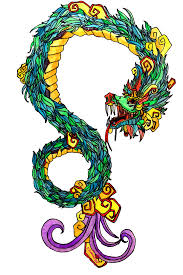
Many of these ancient world symbols live on. Consider this..

This is the flag and logo of the WHO (World Health Organization). Ever noticed the serpent and staff at its centre? Well…that too is drawn from ancient symbols – this one from the Rod of Asclepius from Greek Mythology. (TO read more about this story and why the serpent is on the flag of the WHO – read my article on Healing Deities in the Free Press Journal)
Returning home from the world tour, in India, the snake, symbolic of eternity, fertility and mother Earth, finds eternal place as the Shesha Naga upon whom Vishnu rests and also finds pride of place coiled around Shiva’s throat.

Some scholars also believe that the snake cult was one amongst several indigenous religious practices and cults of India. And that with such kind of iconography, these indigenous aboriginal cults were gradually imbibed into Vishnu and Shiva worship. This process of synthesis is referred to as Acculturation.

What’s more – snakes and serpents play a significant part in our legends and our stories. Whether drawn from Mythology or Folklore, serpents have been given a lofty status and venerated across India.
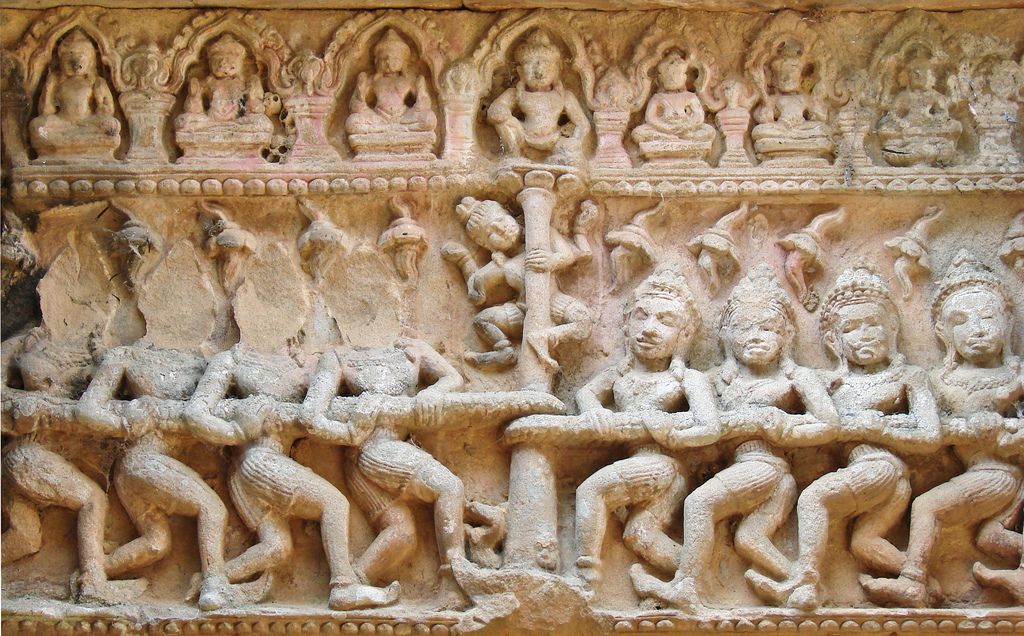
Did you know that the world’s greatest and longest epic – the Mahabharata – begins with snakes? And several interesting episodes of both our great Epics, the Ramayana and the Mahabharata, contain snakes as important characters?
All that and more coming up in India : Land of Serpents and Snakes – Part III.
Also in the upcoming posts : Trees and Flowers in Indian Art – are they just a decorative motif or do they symbolize something deeper? Sign up to the Site Newsletter to stay posted!
More on Understanding Indian Paintings and Symbolism in Indian Art.
More about Snakes and Serpents in India

Nilaxi
February 9, 2019 - 9:08 pm ·The article was very informative enriched our knowledge and changed our perspective towards the significance of snake symbol. Written beautifully eager to read the coming articles
Mallika Ravikumar
February 9, 2019 - 3:45 pm ·Thanks Nilakshi for your appreciation. 🙂
Alisa Kanevsky
March 4, 2019 - 12:31 am ·Perfectly composed written content, thankyou for selective information.
Mallika Ravikumar
March 18, 2019 - 2:39 pm ·Thanks Kanevsky for your appreciation.
SeemaMisra
March 4, 2019 - 8:31 am ·Loved reading the article. Lots of interesting facts.
Mallika Ravikumar
March 4, 2019 - 3:31 am ·Thank you Seema Misra
Shawna Filion
March 15, 2019 - 12:25 am ·I conceive other website owners should take this site as an example , very clean and great user friendly design.
Mallika Ravikumar
March 18, 2019 - 2:32 pm ·Thank you Shawna. Appreciate your writing in
Veronique Guareno
March 16, 2019 - 5:42 am ·I am glad to be one of the visitors on this great internet site (:, regards for posting.